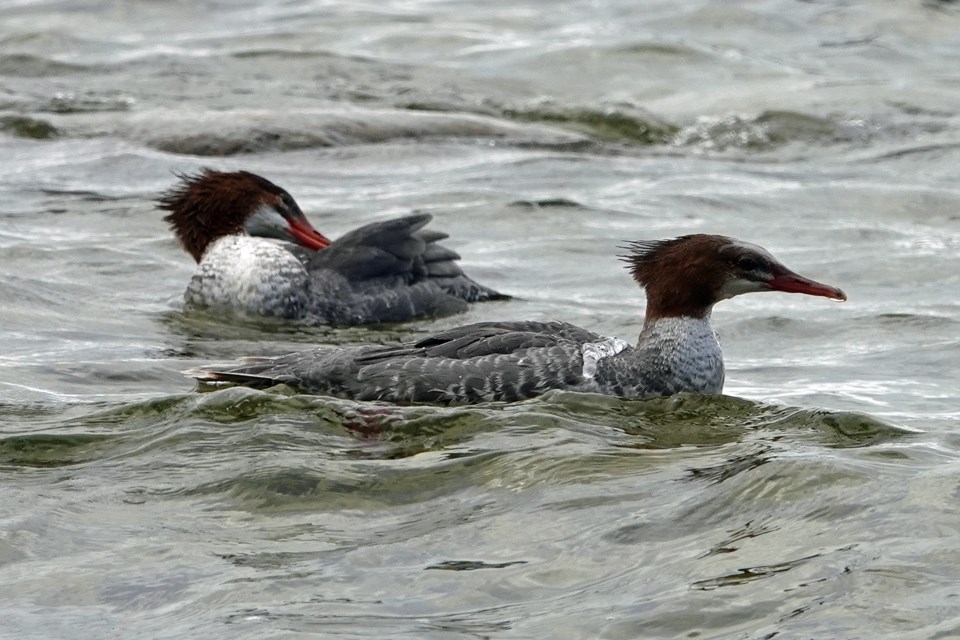The autumn migration of waterfowl is well underway and several species of ducks not usually observed in the summer months are again passing through. Joining our local ‘puddle ducks’ (mallards, wood ducks and teal) are the ‘northerners’ (greater scaup, goldeneye, and ring-neck ducks).
Mixed in with the above flocks will be an assortment of birds that don’t quite look like the usual duck, perhaps more loon-like in shape when seen from afar. But if viewed up close (or with a good telescope) they are quite striking in colour, shape and behaviour. These are the mergansers.
While biologically linked to ducks, they are in a group of their own. Mergansers are specialists in their diet, eating mainly fish, with a dash of crayfish and tadpole for variety.
To catch these slippery menu items, mergansers have a very unique beak which comes with a serrated edge and is shaped like a spear as opposed to most ducks which have a flat beak for sifting and straining mud and vegetation to extract seeds and snails.
We are fortunate to be able to see three species of mergansers in our region, two being quite common and the third usually a seasonal migrant.
The hooded merganser frequents beaver ponds and shallow bays, the male being quite resplendent with a black-bordered white crest that can be raised and lowered like a ship’s sail. While not designed to catch the wind, the raised crest is to catch the attention of a nearby female.
The common merganser (formerly called American merganser) is a more open water bird, quite large, and looking very much like a loon in silhouette. The males are striking black-and-white while the females are the typical muted browns.
The odd-ball species is called a red-breasted merganser, looking like a mix of the previous two. This one likes to nest in the far north of our province so chances of seeing one are usually best in spring migration.
While all three of these share that ‘sawbill’ characteristic, they have other common traits. All are cavity nesters, which means that a big hollow tree makes a prime home for these birds.
The smaller hooded merganser often uses the nesting boxes set up for wood ducks. When the eggs hatch the new youngsters have to leap out of the nest and down to the water’s surface, often many metres below, when they are less than a day old. Their downy fluff acts like a padded life-jacket to cushion the landing and keeps them afloat.
Another merganser ‘thing’ is dump nesting. This refers to their habit of finding another nest already set up and then laying (dumping) her eggs in that already established nest. The new foster mother now has to brood not 12 but 20 eggs, which is why the newly hatched family is often viewed as one exasperated female with many excited youngsters afloat all around her.
While each of the females is outfitted with that drab palette of brown on brown with a dash of white, they all have a wild and crazy head crest. Not as showy as the hooded merganser male, but very distinct rag-tag bristle of stiff feathers; I equate their look to what we might call punk or grunge… not mainstream but stylish and distinct in their own way.
The origin of the name merganser means ‘plunging goose’. As mentioned, their diet is mainly fish, and to catch fish one must plunge below the surface, doing so about 400 times a day (not every plunge ends successfully).
To locate their meal, mergansers swim with their heads bowed into the water, looking like they are going “burble-burble-burble” through the shallow water. To assist in seeing these fleeting silver flashes of fish scales, the mergansers have built in goggles, a transparent eyelid called a nictitating membrane.
On a recent visit to Awenda Provincial Park, we were treated to seeing a couple of female common mergansers hunting the rocky shoreline. By sitting quite still we allowed the birds to manoeuvre very close by us, thus getting some great photographs and having opportunity to observe their relentless pursuit of minnows.
As the fall migration proceeds, larger flocks of mergansers (called a dopping) will be observed locally on the waters of Lake Couchiching and Lake Simcoe. These ‘rafts’ of ducks will include not only the mergansers, but hundreds of common loons and sometimes thousands of ‘northern’ ducks.
A good spotting scope and vantage point will be needed to truly see the wonder of this seasonal movement.



